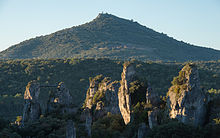



Dolomite (also known as dolomite rock, dolostone or dolomitic rock) is a sedimentary carbonate rock that contains a high percentage of the mineral dolomite, CaMg(CO3)2. It occurs widely, often in association with limestone and evaporites, though it is less abundant than limestone and rare in Cenozoic rock beds (beds less than about 66 million years in age). One of the first geologists to distinguish dolomite from limestone was Déodat Gratet de Dolomieu; a French mineralogist and geologist whom it is named after. He recognized and described the distinct characteristics of dolomite in the late 18th century, differentiating it from limestone.
Most dolomite was formed as a magnesium replacement of limestone or of lime mud before lithification.[1] The geological process of conversion of calcite to dolomite is known as dolomitization and any intermediate product is known as dolomitic limestone.[2][3] The "dolomite problem" refers to the vast worldwide depositions of dolomite in the past geologic record in contrast to the limited amounts of dolomite formed in modern times.[4][5] Recent research has revealed sulfate-reducing bacteria living in anoxic conditions precipitate dolomite which indicates that some past dolomite deposits may be due to microbial activity.[6][7]
Dolomite is resistant to erosion and can either contain bedded layers or be unbedded. It is less soluble than limestone in weakly acidic groundwater, but it can still develop solution features (karst) over time. Dolomite rock can act as an oil and natural gas reservoir.
- ^ Zenger, D. H.; Mazzullo, S. J. (1982). Dolomitization. Hutchinson Ross. ISBN 0-87933-416-9.
- ^ Chilingar, George V.; Bissell, Harold J.; Wolf, Karl H. (1967). "Chapter 5 Diagenesis of Carbonate Rocks". Developments in Sedimentology. 8: 314. doi:10.1016/S0070-4571(08)70844-6. ISBN 9780444533449.
- ^ "Dolomite. A sedimentary rock known as dolostone or dolomite rock". Geology.com. Retrieved 20 June 2014.
- ^ Fowles, Julian (25 October 1991). "Dolomite: the mineral that shouldn't exist - Scientists have never been able to make dolomite in the way the mineral forms naturally. Theories have come and gone, but the mystery of its origins remains". New Scientist. Retrieved 2021-05-31.
- ^ Arvidson, Rolf S.; Mackenzie, Fred T. (1999-04-01). "The dolomite problem; control of precipitation kinetics by temperature and saturation state". American Journal of Science. 299 (4): 257–288. Bibcode:1999AmJS..299..257A. doi:10.2475/ajs.299.4.257. ISSN 0002-9599. S2CID 49341088.
- ^ Vasconcelos, Crisogono; McKenzie, Judith A.; Bernasconi, Stefano; Grujic, Djordje; Tiens, Albert J. (1995). "Microbial mediation as a possible mechanism for natural dolomite formation at low temperatures". Nature. 377 (6546): 220–222. Bibcode:1995Natur.377..220V. doi:10.1038/377220a0. ISSN 1476-4687. S2CID 4371495.
- ^ Petrash, Daniel A.; Bialik, Or M.; Bontognali, Tomaso R.R.; Vasconcelos, Crisógono; Roberts, Jennifer A.; McKenzie, Judith A.; Konhauser, Kurt O. (August 2017). "Microbially catalyzed dolomite formation: From near-surface to burial". Earth-Science Reviews. 171: 558–582. Bibcode:2017ESRv..171..558P. doi:10.1016/j.earscirev.2017.06.015.